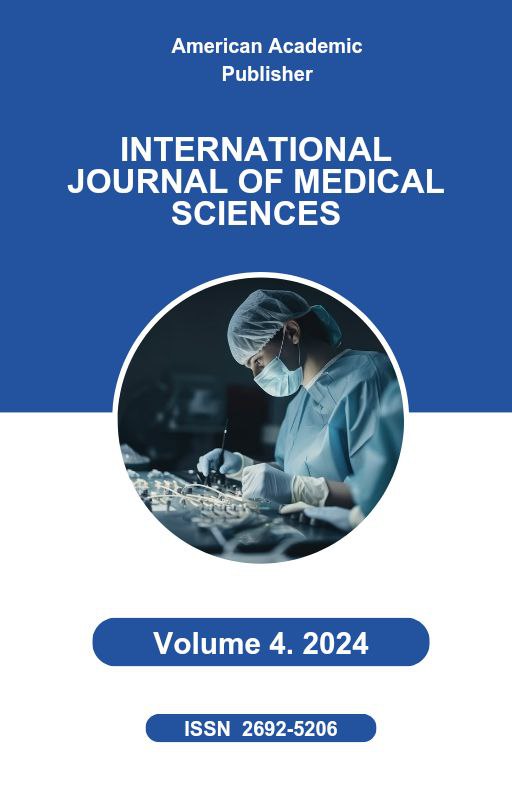 Articles
| Open Access |
https://doi.org/10.55640/
Articles
| Open Access |
https://doi.org/10.55640/
EFFECTIVENESS OF RUTAN IN CORRECTING DISORDERS OF LIPID PEROXIDATION IN PREPUBERTAL RATS WITH ACUTE TOXIC HEPATITIS
Ziyaviddin Z. Khakimov¹, Alisher H. Rakhmanov², Fatima A. Khalmuratova³ , ¹Doctor of Medical Sciences, Professor, Department of Pharmacology, Tashkent State Medical University ²Doctor of Medical Sciences, Professor, Researcher, Biomedical Center, Tashkent State Medical University ³Assistant, Department of Pharmacology and Pharmaceutical Technology, Karakalpak Medical Institute, UzbekistanAbstract
Considering the increasing incidence of toxic liver damage—the primary organ for xenobiotic detoxification—the insufficient effectiveness of currently used pharmacological treatments necessitates the search for and implementation of new effective drugs for treating hepatobiliary system pathology in prepubertal patients. In this context, the authors studied the effects of Rutan and Karsil on the levels of lipid peroxidation products (Acylhydroperoxides [AcGP], malondialdehyde [MDA]) and the activity of antioxidant enzyme systems (catalase [CAT], superoxide dismutase [SOD]) in the liver during acute hepatitis induced by carbon tetrachloride in one-month-old rats. Results showed that Rutan, similarly to Karsil, reduces elevated levels of AcGP and MDA in the microsomal-cytosolic liver fraction significantly increased by acute toxic hepatitis induced by carbon tetrachloride. Notably, this effect is accompanied by increased activity of antioxidant enzyme systems. It was concluded that Rutan may be used in the treatment of acute liver diseases in the prepubertal period.
Keywords
acute toxic hepatitis, rats, prepubertal period, liver, free radical oxidation, antioxidant defense enzymes.
References
Blinova E.V., Khalzova M.A., Blinov D.S., Yakhya M.Kh.S., Meleshkin A.I., Kurganov N.A., Geroeva O.I. Hepatoprotective activity of an organic magnesium compound in pregnant rats with experimental hepatitis. Experimental and Clinical Pharmacology. 2018; 81(4):18-21.
Simonova N.V., Dorovskikh V.A., Bondarenko D.A., Nosal L.A., Shtarberg M.A. Comparative efficacy of Remaxol and Reamberin in liver damage by carbon tetrachloride in experiment. Experimental and Clinical Pharmacology. 2018; 81(7):29-33.
Molochkova O.V., Kovalev O.B., Konev V.A., Uchaykin V.F., Snetkova Y.S. Drug-induced hepatitis in children. Pediatric Infections. 2017; 16(1):42-50.
Molostvova A.F., Khabirova G.I., Kharisova Yu.I., Salimova L.M. Drug-induced liver damage - modern view on the topical problem. Bulletin of Modern Clinical Medicine. 2022; 15(5):107-115.
Lupanova I.A., Ferubko E.V., Kurmanova E.N., Shishkanov D.V., Saibel O.L. Study of hepatoprotective activity of dry extract of Jerusalem artichoke herb in a toxic hepatitis model in rats. Pathological Physiology and Experimental Therapy. 2022; 66(4):138-142.
Hakimov Z.Z., Rakhmanov A.Kh., Mavlanov Sh.R. Effectiveness of medicinal plant extract mixtures in correcting liver functional status disorders of various etiologies. Tashkent, TMA Publishing, 2021. – 156 p.
Demidov V.N., Nazarenko O.A., Egorova E.Yu. et al. Efficacy of Progepar in experimental liver damage caused by alcohol and paracetamol. Pharmateka, 2011; 2: 85–90.
Nikolaev S.M. Phyto-pharmacotherapy and phytoprophylaxis of diseases. Ulan-Ude: 2012; 286 p.
Sema Mandal, Ruth Simmons, Georgina Ireland, et al. Pediatric acute hepatitis of unknown etiology: a national investigation and adenoviraemia case-control study in the UK. The Lancet Child & Adolescent Health. 2023; 7(11):786-796.
Abzalov Sh.R., Khakimov Z.Z., Rakhmanov A.Kh. The Effect of Dry Extract Obtained from Rhus Cariaria in Experimental Models of Edema and Inflammation. American Journal of Medicine and Medical Sciences. 2020; 10(7):503-508.
Khakimov Z.Z., Rakhmanov A.Kh., Abzalov Sh.R. Influence of RHUS Coriaria L. leaf extract on chronic arthritis progression. Medical Journal of Uzbekistan. 2024; 2:182-188.
Mavlonov A.A., Boboeva R.R. Study of the hepatoprotective action of Rutan. Academicia: an International Multidisciplinary Research Journal. 2020; 10(5):117-120.
Aripov T.F., Ghaibov U.G., Ghaibova S.N., Abdullaev A.A., Abduazimova D.Sh., Oschepkova Yu.I., Salikhov Sh.I. Antioxidant and antiradical activity in vitro of polyphenol mixture (active substance of antiviral drug Rutan) from RHUS CORIARIA L. leaves. Chemistry of Plant Raw Materials. 2024; 4:138-147.
Mavlanov Sh.R., Khakimov Z.Z., Rakhmanov A.Kh. Experimental methods for studying the effects of new pharmacologically active compounds on hepatobiliary system function. Methodological Guide, Tashkent, 2017. – 63 p.
Rakitskii V.N., Skupnevskii S.V. Seasonal variations of carbon tetrachloride toxicity. Hygiene and Sanitation. 2019; 98(3):324-327.
Timasheva G.V., Repina E.F., Karimov D.O., et al. Peculiarities of metabolic changes in experimental animals at early terms of pharmacological correction of toxic liver diseases. Toxicological Review. 2020;(1):13-19.
Hsu Y-W, Chen Y-Y, Tsai C-F. Protective Effects of Chlorogenic Acid against Carbon Tetrachloride-Induced Hepatotoxicity in Mice. Processes. 2022; 10(1):31.
Gildikov D.I. Oxidative stress in animals: a pathophysiologist's perspective. Russian Veterinary Journal. 2020; 4:10–18.
Averyanova E.V., Shkolnikova M.N., Chugunova O.V., Mazko O.N. Effects of triterpenoids in fatty products on liver condition of laboratory animals with acute toxic hepatitis. Problems of Nutrition. 2023; 92(4):81-91.
Unsal V., Cicek M., Sabancilar İ. Toxicity of carbon tetrachloride, free radicals and role of antioxidants. Rev Environ Health. 2020 Sep 25;36(2):279-295.
Article Statistics
Downloads
Copyright License

This work is licensed under a Creative Commons Attribution 4.0 International License.

